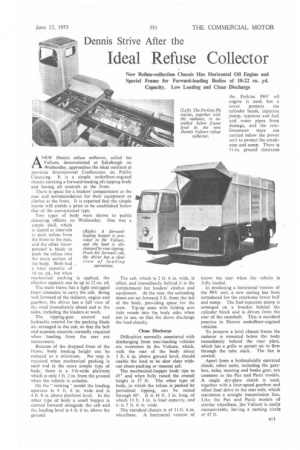Dennis Strive After the
Page 45

If you've noticed an error in this article please click here to report it so we can fix it.
Ideal Refuse Collector
New Refuse-collection Chassis Has Horizontal Oil Engine and Special Frame for Forward-loading Bodies of 18-22 cu. yd. Capacity. Low Loading and Clean Discharge ANEW Dennis refuse collector, called the Vulture, demonstrated at Edinburgh on Wednesday, approaches the ideal outlined at previous International Conferences on Public Cleansing. It is a simple underfloor-engined chassis carrying a forward-loading aft-tipping body and having all controls at the front.
There is space for a loaders' compartment at the rear and accommodation for their equipment or clothes at the front. It is expected that the simple layout will enable a price to be established below that of the conventional type.
Two types of body were shown to public cleansing officers on Wednesday. One was a simple shell, which is tipped at intervals to pack refuse from the front to the rear, and the other incorporated a blade to push the refuse into the main section of the body. Both had a total capacity of 18 cu. yd., but when mechanical packing is applied, the effective capacity can be up to 22 cu. yd.
The main frame has a light outtigged front extension to carry the cab. Being well forward of the radiator, engine and gearbox, the driver has a full view of the. road immediately ahead and at the sides, including the loaders at work.
The tipping-gear control and hydraulic control for the packing blade are arranged in the cab, so that the bell and separate controls normally required when loading from the rear are unnecessary.
Because of the dropped front of the frame, body loading height can be reduced to a minimum. No step is required when mechanical packing is used and in the more simple type of body, there is a 5-ft-wide platform which is only 1 ft. 2 in. from the ground when the vehicle is unladen.
On the " rocking " model the loading aperture is 4 ft. 6 in. wide and is 4 ft. 8 in. above platform level, In the other type of body a small hopper is carried forward alongside the cab and the loading level is 4 ft. 6 in. above the ground.
(Right) A forwardloading hopper is provided in the Vulture, and the load is discharged by rear tipping. From his forward cab, the driver has a clear view of loading operations.
The cab, which is 2 ft. 6 in. wide, is offset, and immediately behind it is the compartment for loaders' clothes and equipment. At the rear, the unloading doors are set forward 3 ft. from the tail of the body, providing space for the crew. Tip-up seats with folding arm rails recede into the body sides when not in use, so that the doors discharge the load cleanly.
Clean Discharge Difficulties normally associatedwith discharging from rear-loading sehicles are overcome in the Vulture, which, with the rear of the body about 3 ft. 6 in. above ground level, should enable the load to be shot clear without shunt-packing or manual aid.
The mechanical-hopper body tips to 4Y and when fully raised the overall height is 17 ft. The other type of body, in which the refuse is packed by periodical tipping, can be raised through 60'. It is 16 ft. 3 in. long, of which 13 ft. 3 in, is load capacity, and it is 7 ft. 6 in. wide.
The 'standard chassis is of 11-ft. 6-in. wheelbase. A horizontal version of
the Perkins P6V oil engine is used, but a cover protects the cylinder heads, injection pump, injectors and fuel and water pipes from damage, and the reinforcement stays are carried below the power unit to protect the crankcase and sump. There is 11-in, ground clearance
below the tray when the vehicle is fully loaded.
In producing a horizontal version of the P6V unit, a new casting has been introduced for the crankcase lower half and sump. The fuel-injection pump is arranged on a bracket behind the cylinder block and is driven from the rear of the camshaft. This is standard practice in Dennis underfloor-engined vehicles.
To preserve a level chassis frame the radiator is mounted below the body immediately behind the riser plate, which has a grille to permit air to flow through the tube stack. The fan is cowled.
Apart from a hydraulically operated clutch, other units, including the gearbox, axles, steering and brake gear, are common to the Pax and Paxit models. A single dry-plate clutch is used, together with a four-speed gearbox and offset final drive to the rear axle, which maintains a straight transmission line. Like the Pax and Paxit models of similar wheelbase, the Vulture is easily manceuvrable, having a turning circle of 47 ft.




































































































